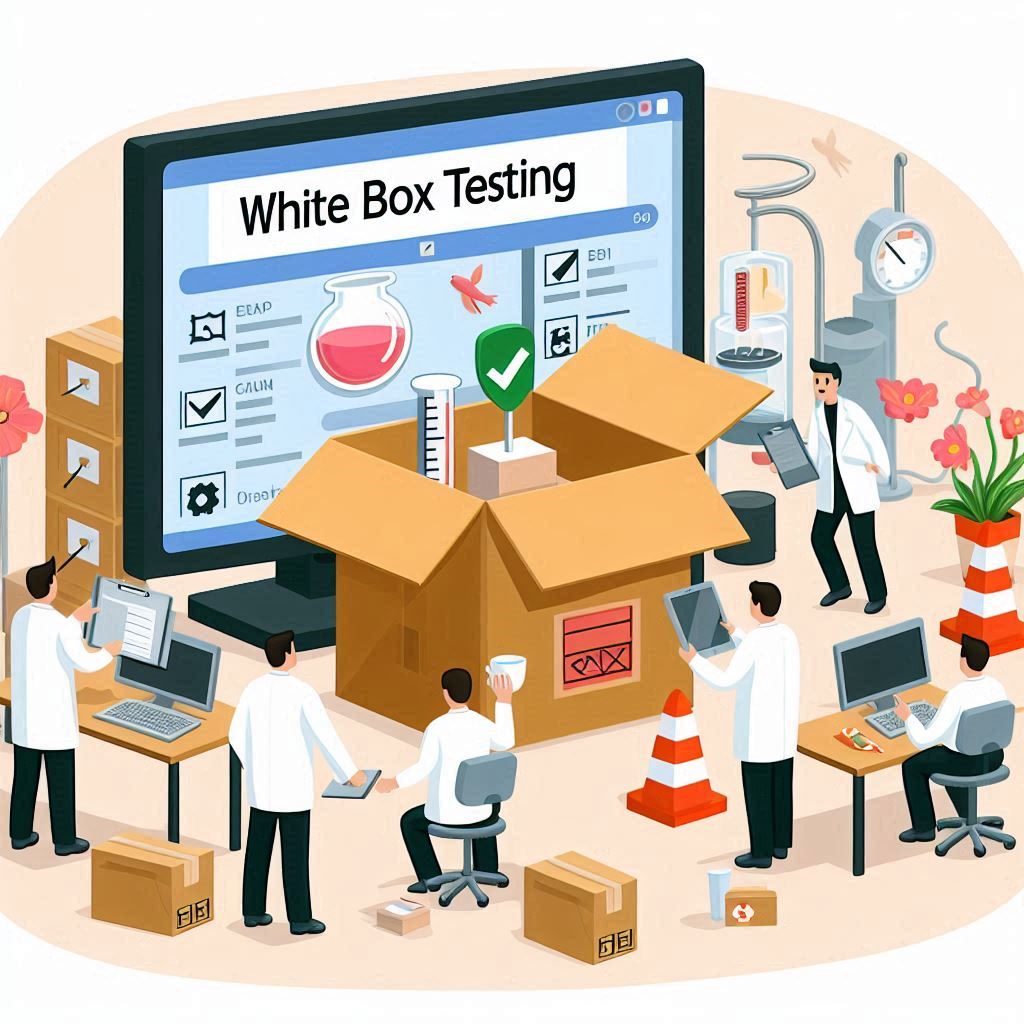White Box Testing Explained: Types, Tools, and Step-by-Step Process

In the dynamic realm of software development, ensuring the quality and reliability of software products is paramount. One critical aspect of this quality assurance process is software testing, and within this domain, white box testing stands out for its thorough and detailed approach. In this comprehensive blog, we will delve into the definition, types, and techniques of white box testing, highlighting its significance in delivering robust software. Additionally, we’ll showcase the expertise of Webatlas in providing exceptional software testing services.
What is White Box Testing?
White box testing, also known as clear box testing, glass box testing, or transparent testing, is a method of testing software that involves examining the internal workings of an application. Unlike black box testing, which focuses solely on input and output, white box testing delves into the code structure, logic, and implementation. Testers require knowledge of the underlying code and algorithms to design effective test cases.
The primary goal of white box testing is to ensure that the software’s internal operations are functioning correctly and efficiently. This method allows testers to identify hidden errors, optimize code, and enhance overall software quality.
Also Read- Non-Functional Testing: Types, Tools & Process for Exceptional Software
Importance of White Box Testing
White box testing is crucial for several reasons:
- Early Bug Detection: By examining the code at an early stage, white box testing helps identify and rectify errors before they escalate into major issues.
- Thorough Coverage: It ensures that all code paths, branches, and conditions are tested, leaving no room for hidden defects.
- Code Optimization: White box testing facilitates code optimization by identifying redundant or inefficient code segments.
- Security Assurance: It helps uncover security vulnerabilities, ensuring that the software is robust against potential threats.
- Improved Code Quality: By adhering to coding standards and best practices, white box testing enhances the overall quality of the codebase.
Types of White Box Testing
White box testing encompasses several types, each focusing on different aspects of the code. The primary types include:
1. Unit Testing
Unit testing involves testing individual components or units of code in isolation. These units can be functions, methods, or classes. The primary objective is to verify that each unit functions as intended. Unit tests are typically automated and executed frequently during the development process to catch defects early.
2. Integration Testing
Integration testing examines the interactions between different units or modules of the software. The goal is to ensure that these integrated units work together harmoniously. Integration testing helps identify interface defects and issues related to data exchange between modules.
3. Regression Testing
Regression testing is performed to ensure that recent code changes or updates have not adversely affected the existing functionality. It involves re-running previously executed test cases to verify that the software still behaves as expected. Regression testing is crucial for maintaining software stability over time.
4. Code Coverage Testing
Code coverage testing measures the extent to which the code is exercised by the test cases. It identifies untested code paths and helps ensure comprehensive test coverage. Common metrics used in code coverage testing include statement coverage, branch coverage, and path coverage.
5. Security Testing
Security testing aims to identify vulnerabilities and weaknesses in the software’s code that could be exploited by malicious entities. Techniques such as code reviews, static analysis, and penetration testing are employed to uncover potential security flaws.
Techniques of White Box Testing
White box testing employs various techniques to thoroughly examine the code. Some of the most widely used techniques include:
1. Statement Coverage
Statement coverage ensures that every line of code is executed at least once during testing. This technique helps identify code segments that are never executed and ensures that all statements are tested.
2. Branch Coverage
Branch coverage, also known as decision coverage, focuses on testing all possible branches or decision points in the code. It ensures that each branch is executed and validated, helping uncover defects in decision-making logic.
3. Path Coverage
Path coverage involves testing all possible execution paths in the code. This technique aims to ensure that every possible path is executed, including all combinations of decisions and loops.
4. Condition Coverage
Condition coverage, also known as predicate coverage, ensures that all logical conditions within the code are tested with both true and false outcomes. This technique helps identify defects in complex logical expressions.
5. Loop Testing
Loop testing focuses on validating the behavior of loops within the code. It involves testing different scenarios, such as zero iterations, one iteration, and multiple iterations, to ensure that loops function correctly under various conditions.
6. Data Flow Testing
Data flow testing examines the flow of data within the code, tracking the lifecycle of variables and data structures. It helps identify anomalies such as uninitialized variables, unused variables, and improper data handling.
Best Practices for White Box Testing
To maximize the effectiveness of white box testing, it is essential to follow best practices:
- Automate Tests: Automated testing tools can significantly enhance the efficiency and accuracy of white box testing. They enable frequent and consistent execution of test cases.
- Maintain Test Cases: Regularly update and maintain test cases to reflect code changes and new functionality. This ensures that tests remain relevant and effective.
- Collaborate with Developers: Testers and developers should work closely to understand the code and identify potential areas of concern. Collaboration fosters a deeper understanding of the codebase.
- Use Code Reviews: Conduct code reviews to identify defects and improve code quality. Peer reviews help catch issues that automated tools might miss.
- Focus on High-Risk Areas: Prioritize testing high-risk areas of the code that are more likely to contain defects or have a significant impact on the software’s functionality.
Challenges of White Box Testing
While white box testing offers numerous benefits, it also presents certain challenges:
- Complexity: Understanding and testing complex code structures can be time-consuming and require significant expertise.
- Time-Consuming: Designing and executing detailed test cases can be time-intensive, especially for large codebases.
- Maintenance: As the code evolves, maintaining and updating test cases to reflect changes can be challenging.
- Skill Requirements: White box testing requires a deep understanding of the code, algorithms, and programming languages, necessitating skilled testers.
The Role of Webatlas in Software Testing
Webatlas is a leading provider of comprehensive software testing services, offering a wide range of testing solutions to ensure the quality and reliability of software products. With years of experience and a team of skilled professionals, Webatlas excels in delivering top-notch testing services tailored to meet the unique needs of each client.
Expertise in White Box Testing
Webatlas specializes in white box testing, leveraging advanced techniques and tools to deliver thorough and effective testing solutions. Our team of experts possesses deep knowledge of various programming languages and frameworks, enabling us to conduct detailed code analysis and identify potential issues at an early stage.
Customized Testing Solutions
At Webatlas, we understand that each software project is unique. Therefore, we offer customized testing solutions that align with the specific requirements and goals of our clients. Our approach involves close collaboration with development teams to ensure seamless integration of testing processes into the development lifecycle.
Cutting-Edge Tools and Technologies
We utilize state-of-the-art testing tools and technologies to enhance the efficiency and accuracy of our testing processes. Our commitment to staying updated with the latest industry trends ensures that we deliver the highest quality testing services.
Comprehensive Test Coverage
Webatlas ensures comprehensive test coverage by employing a combination of manual and automated testing techniques. Our rigorous testing methodologies help identify and rectify defects, optimize code performance, and enhance overall software quality.
Proven Track Record
With a proven track record of successful projects across various industries, Webatlas has earned a reputation for delivering exceptional testing services. Our clients trust us to provide reliable and efficient testing solutions that contribute to the success of their software products.
Conclusion
White box testing is an indispensable component of the software development process, offering a detailed and thorough approach to ensuring code quality and reliability. By understanding the internal workings of the software, white box testing helps identify hidden defects, optimize code performance, and enhance overall software security.
Webatlas stands out as a leader in the field of software testing, offering specialized white box testing services that cater to the unique needs of each client. With a focus on customized solutions, cutting-edge tools, and comprehensive test coverage, Webatlas is committed to delivering top-notch testing services that contribute to the success of software projects.
Whether you’re developing a new software application or seeking to enhance the quality of an existing one, white box testing, backed by the expertise of Webatlas, ensures that your software meets the highest standards of quality and reliability. Trust Webatlas for all your software testing needs and experience the difference that professional testing services can make.
Recent Post
Let's talk about your project, or just come and say hello!
Webatlas Technologies is the fastest growing web and mobile app development company



